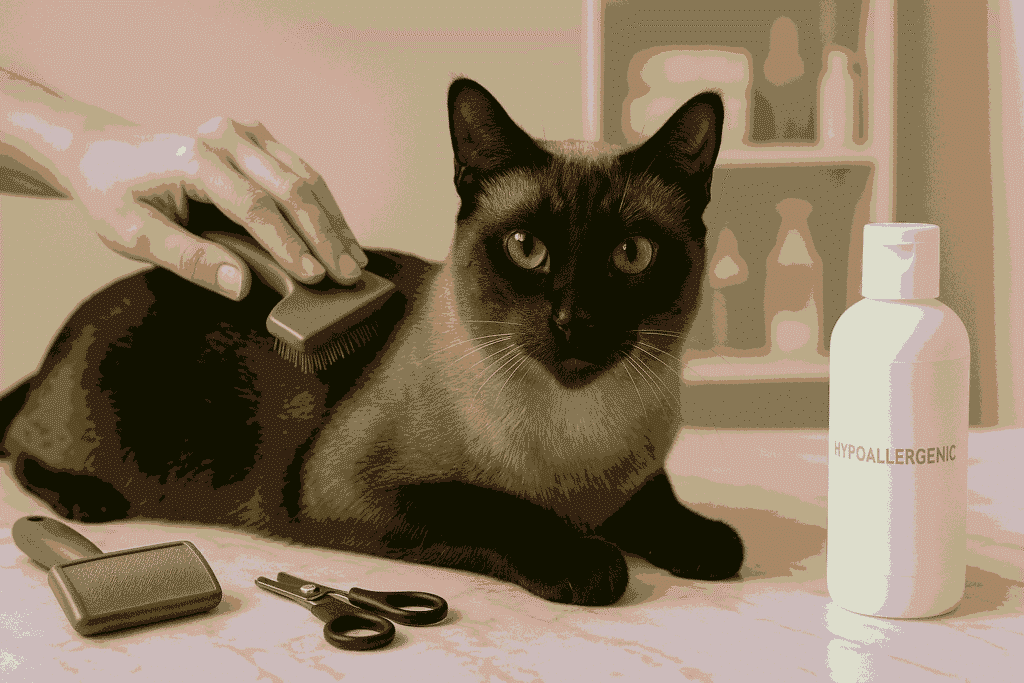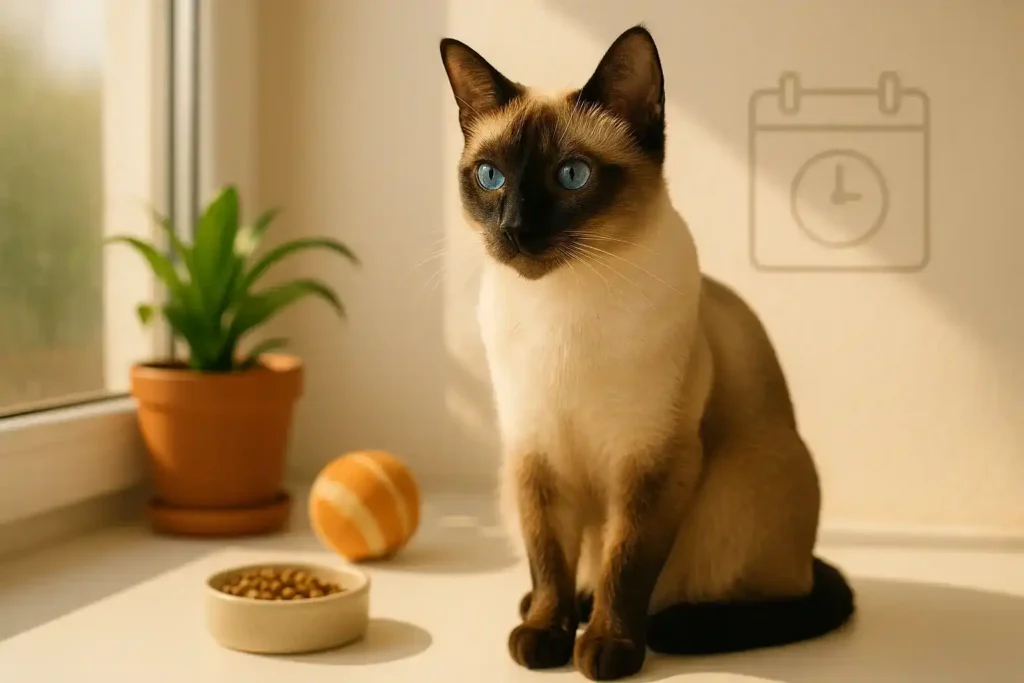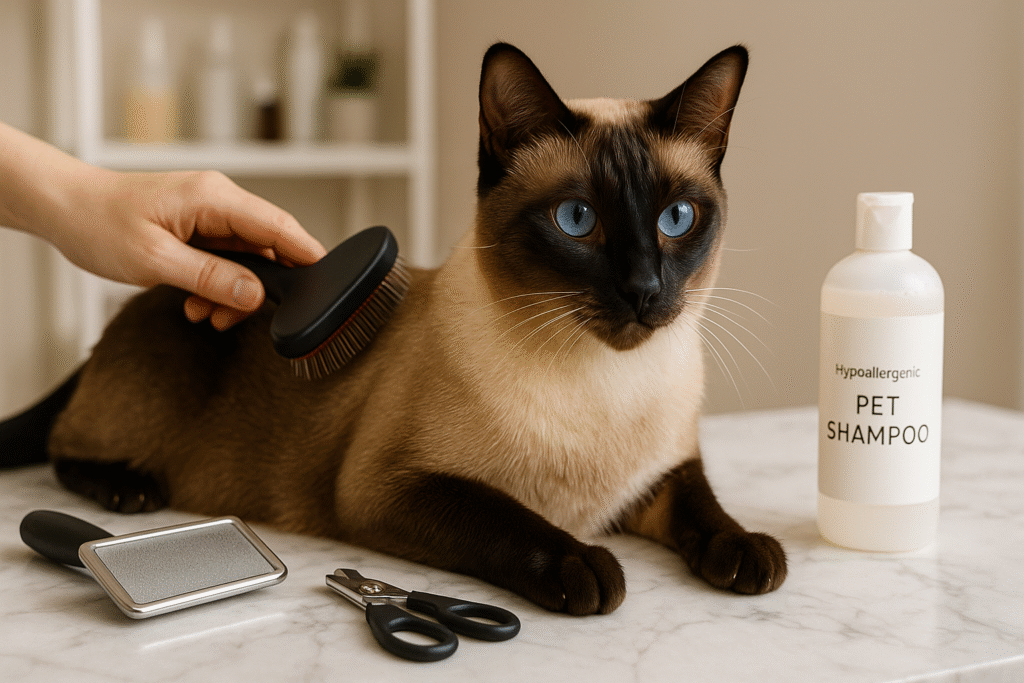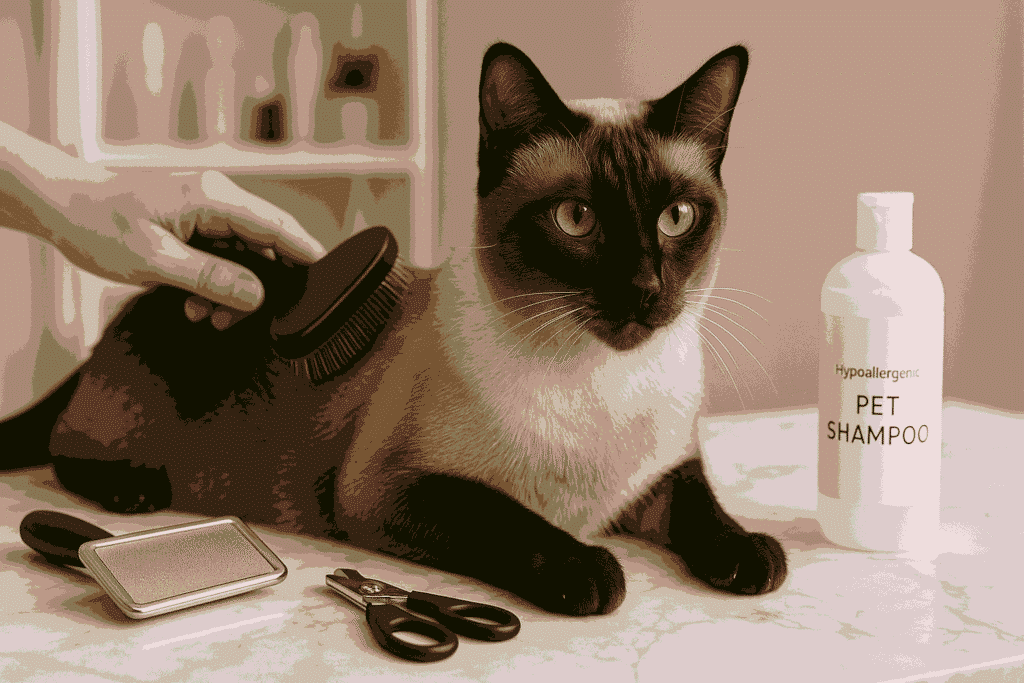Siamese cats are one of the most loved cat breeds worldwide. They are known for their striking looks, bright blue eyes, and playful, social nature. Within the breed, there are two main types: traditional Siamese, sometimes called applehead or Thai cats, and modern Siamese, also known as wedgehead or show-style Siamese. Each type has distinct features, personality traits, and care needs.
Traditional Siamese cats have round faces, muscular bodies, and a calmer personality. Modern Siamese cats are sleek, have wedge-shaped heads, and are more energetic and vocal. Both share intelligence, social nature, and love for attention, but their appearance, temperament, and health traits differ. Knowing these differences is essential for anyone thinking of adopting or buying a Siamese cat.
This guide covers everything you need to know. You will learn about physical traits, personality, health, lifespan, cost, breeders, and care requirements for both types. By the end, you can decide which Siamese cat fits your lifestyle best.
-
Origins and history of traditional and modern Siamese cats
-
Physical differences: head shape, body, eyes, ears, and coat
-
Personality traits and behavior patterns
-
Health issues and lifespan differences
-
Cost, availability, and reputable breeders
-
Choosing the right type for your home and lifestyle
-
Care, grooming, and daily maintenance
-
FAQs answering common questions about the breed
Traditional vs Modern Siamese Cats: A Complete Guide
Siamese cats are one of the most iconic and beloved cat breeds in the world. Known for their striking appearance, intelligence, and social nature, they are highly sought after by cat lovers globally. Within the Siamese breed, there are distinct types: traditional Siamese cats, often referred to as applehead or Thai cats, and modern Siamese cats, sometimes called wedgehead or show-style Siamese. Understanding the differences between these two types is essential for prospective owners, breeders, and enthusiasts alike.
Whether you are looking to adopt, buy from a breeder, or simply want to understand their history, this guide covers all aspects of traditional and modern Siamese cats including appearance, personality, health, cost, and breeder information.
Origins and History
Siamese cats originate from Thailand, historically called Siam, and were initially brought to Europe in the late 19th century. Traditional Siamese cats preserve the original look of the breed with rounded features and muscular builds, often referred to as Thai or old-style Siamese.
Over the 20th century, breeders developed modern Siamese cats to meet show standards, emphasizing sleek, wedge-shaped heads and elongated bodies. The modern style became popular in cat shows and pet homes that favored a more dramatic appearance.
Both types share a common heritage, but selective breeding has emphasized different physical and personality traits over generations.
Key Points:
-
Traditional Siamese = Applehead, Thai, Old-style
-
Modern Siamese = Wedgehead, show-style
-
Originated in Thailand (Siam)
-
Modern Siamese bred for appearance and show
-
Traditional preserves original breed traits
Summary: Traditional and modern Siamese share a heritage but diverge in appearance due to selective breeding.
Physical Appearance
The most noticeable differences lie in physical appearance. Traditional Siamese cats have round heads, stocky bodies, and medium-sized ears, while modern Siamese cats are slender, with wedge-shaped heads and large, pointed ears.
Eye color and body proportions also differ. Traditional types have almond-shaped eyes that are deep-set, whereas modern Siamese have striking, slanted blue eyes. Their coat patterns, including seal point, lilac point, and lynx point, remain common across both types but may appear more dramatic in modern cats.
A simple table helps summarize these differences:
| Feature | Traditional Siamese | Modern Siamese |
|---|---|---|
| Head Shape | Round / Applehead | Wedge / Triangular |
| Body | Muscular, stocky | Slim, elongated |
| Ears | Medium, rounded | Large, pointed |
| Eyes | Almond-shaped, deep-set | Slanted, wide-set |
| Tail | Thick, medium-length | Long, slender |
Key Points:
-
Head shape is the primary visual difference
-
Body type: muscular vs slender
-
Ear and eye structure differ significantly
-
Coat patterns are shared but appear sharper in modern types
-
Tail length and thickness differ
Summary: Visual differences are pronounced, helping prospective owners distinguish between traditional and modern Siamese.
Personality and Behavior
Personality traits are another critical factor when choosing between traditional and modern Siamese cats. Both types are social, intelligent, and vocal, making them ideal companions for interactive households.
Traditional Siamese are often calmer, affectionate, and adaptable to quieter home environments. In contrast, modern Siamese are more energetic, demanding attention, and highly vocal. Gender can also influence behavior, with males often being more playful and females slightly more reserved.
Personality quirks, such as separation anxiety or attention-seeking behavior, may appear in both types but are often more pronounced in modern show-style cats.
Key Points:
-
Both are intelligent and social
-
Traditional = calmer, affectionate
-
Modern = energetic, vocal, attention-seeking
-
Male vs female personality differences
-
Common personality issues: anxiety, clinginess
Summary: Understanding personality differences is essential to matching a Siamese cat to your household lifestyle.
Health and Lifespan
Health is a critical consideration. Traditional Siamese cats are generally robust, with fewer breed-related issues, whereas modern Siamese cats may face health problems due to selective breeding for show traits.
Common concerns in modern Siamese include respiratory issues, dental problems, and heart conditions, while traditional types are more resilient. Both types require regular veterinary care, preventive health checks, and monitoring for breed-specific concerns.
| Health Aspect | Traditional Siamese | Modern Siamese |
|---|---|---|
| Lifespan | 12–20 years | 10–15 years |
| Common Issues | Minor dental, occasional heart | Respiratory, dental, heart, genetic issues |
| Robustness | Strong, resilient | Prone to selective breeding issues |
| Preventive Care | Standard vet check-ups | Essential genetic and health screening |
| Exercise Needs | Moderate | High, mentally and physically active |
Key Points:
-
Traditional Siamese = generally healthy, long lifespan
-
Modern Siamese = prone to selective breeding health issues
-
Preventive care is critical for both
-
Genetic screening recommended for breeders
-
Regular vet visits ensure longevity
Summary: Health considerations vary between the two types, with traditional Siamese generally having fewer complications.
Cost and Availability
Traditional Siamese are often more affordable and easier to find, whereas modern Siamese may carry a higher price due to selective breeding and show popularity. Prices vary depending on lineage, breeder reputation, and region.
In the UK, modern Siamese breeders can be found in Cardiff, Swansea, Yorkshire, and other areas. Reputable breeders often provide certificates, health guarantees, and guidance for new owners. Additionally, adoption options exist through organizations like RSPCA for retired or rescue Siamese cats.
Key Points:
-
Traditional = lower cost, more readily available
-
Modern = higher cost, show-style demand
-
Breeder reputation affects pricing
-
Adoption options available (rescue/Siamese rehoming)
-
Regional differences in availability (UK, Cardiff, Swansea)
Summary: Cost and availability can guide decisions for potential owners, emphasizing the importance of reputable sources.
Choosing the Right Type
Selecting between traditional and modern Siamese depends on your lifestyle. Families or individuals seeking a calm, affectionate companion may prefer traditional Siamese, while those wanting an energetic, attention-seeking cat may enjoy modern Siamese.
Both types require engagement, mental stimulation, and social interaction. Consider home environment, activity level, and personal preference in deciding which type suits your household.
Key Points:
-
Lifestyle determines suitability
-
Traditional = calm, family-friendly
-
Modern = energetic, vocal
-
Both need attention and engagement
-
Evaluate space and activity compatibility
Summary: Matching a Siamese type to your lifestyle ensures a happy cat and owner.
FAQs
What is the difference between traditional and modern Siamese?
Traditional = round heads, stocky bodies; Modern = wedge-shaped heads, slender bodies.
Are modern Siamese more prone to health issues?
Yes, due to selective breeding for show traits.
Which is better for families with children?
Traditional Siamese are often calmer and more adaptable.
Can traditional and modern Siamese interbreed?
Yes, but offspring may inherit mixed traits.
Where can I find reputable breeders?
UK breeders include Cardiff, Swansea, Yorkshire; ensure they provide certificates and health checks.
How much do Siamese cats cost?
Traditional = moderate; Modern = higher due to show lineage and breeder reputation.
What are popular coat colors?
Seal point, blue point, lilac point, lynx point are common in both types.
Do personalities differ by gender?
Yes, males are often more playful; females slightly more reserved.
Are Thai cats the same as traditional Siamese?
Yes, Thai cats are essentially traditional Siamese preserving original breed traits.
Are rescue Siamese available?
Yes, through RSPCA or other adoption channels, including retired Siamese cats.
Conclusion
Choosing between traditional and modern Siamese cats depends on your priorities, whether it’s appearance, personality, or health. Traditional Siamese offer classic charm, robustness, and calmer behavior, while modern Siamese provide striking looks, energy, and show-style appeal.
Prospective owners should consider lifestyle, budget, and long-term care before making a decision. Always seek reputable breeders or adoption agencies and provide ongoing attention, mental stimulation, and healthcare to ensure your Siamese thrives.



